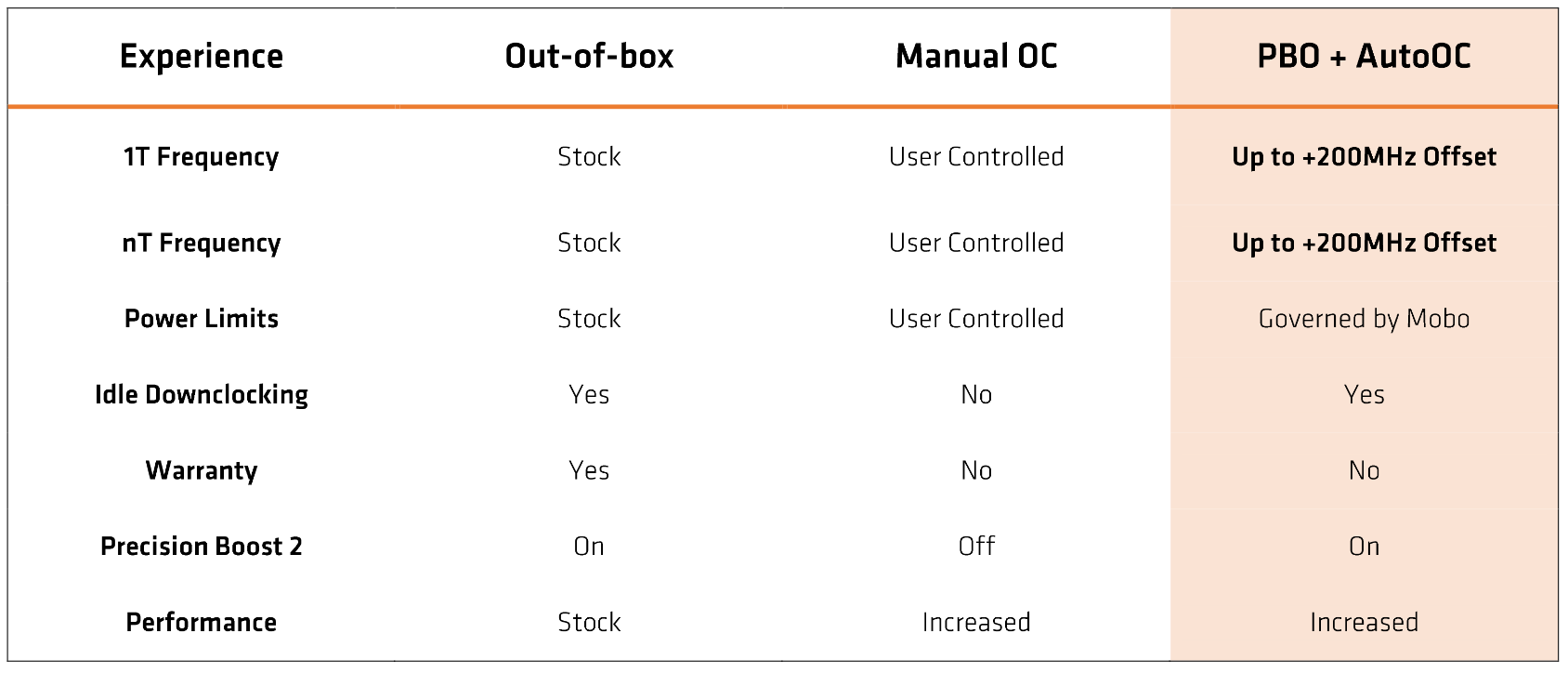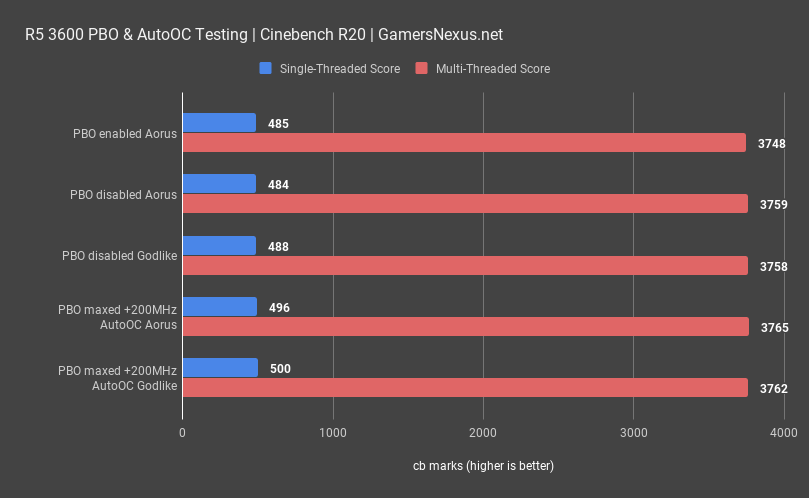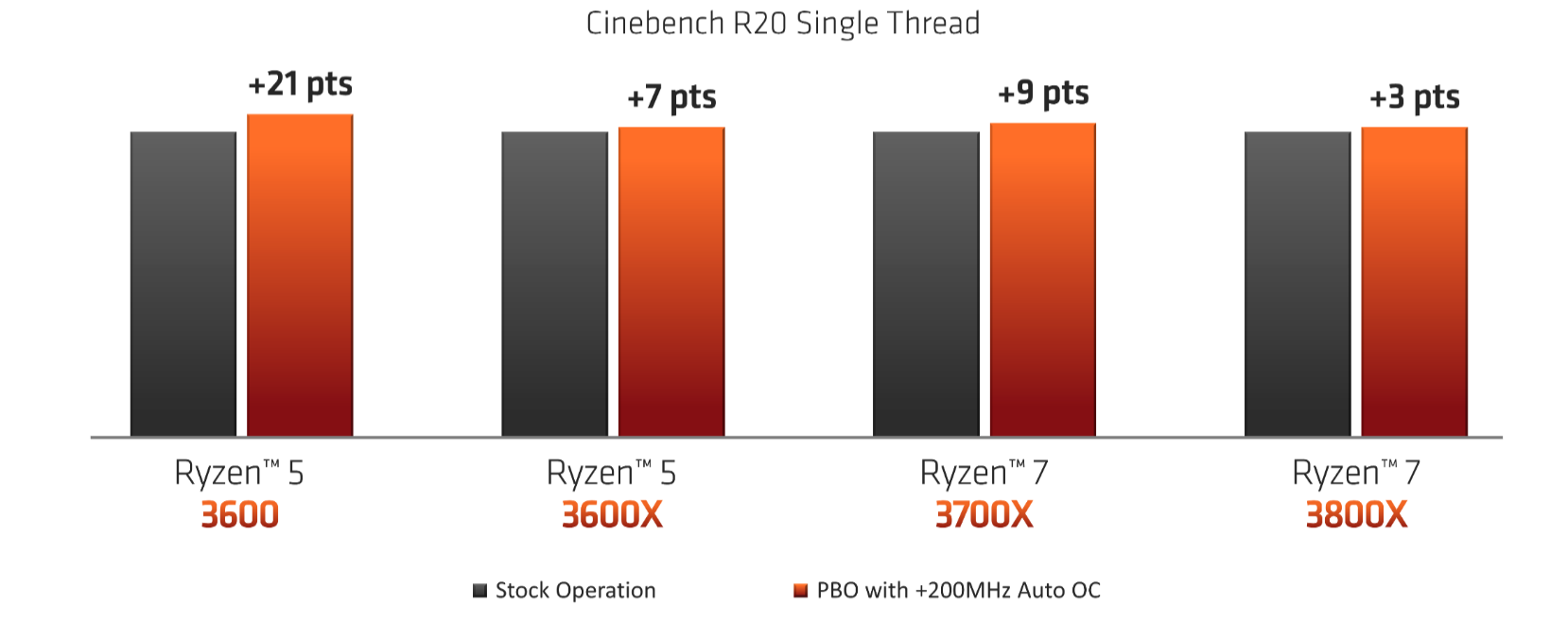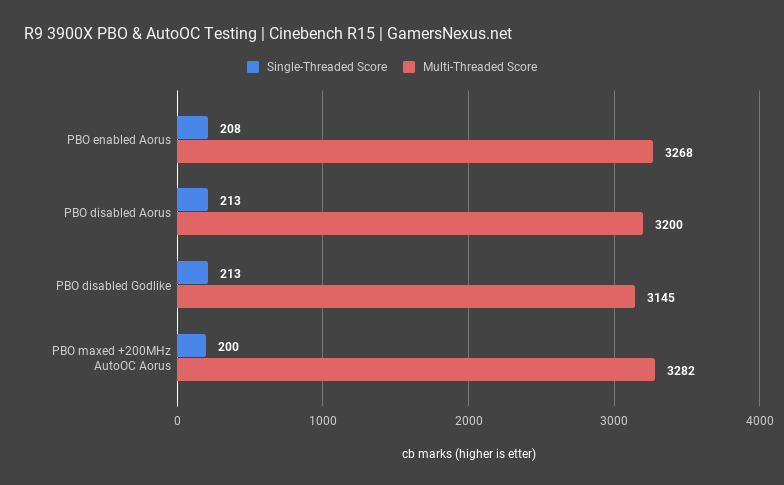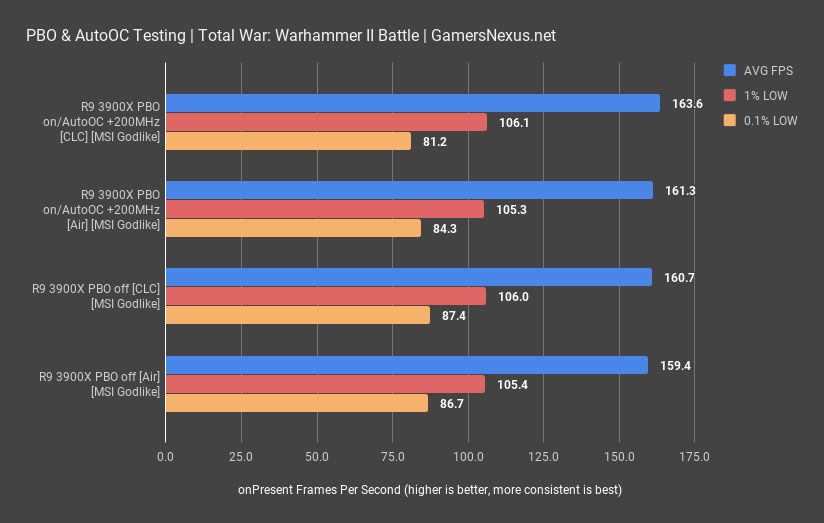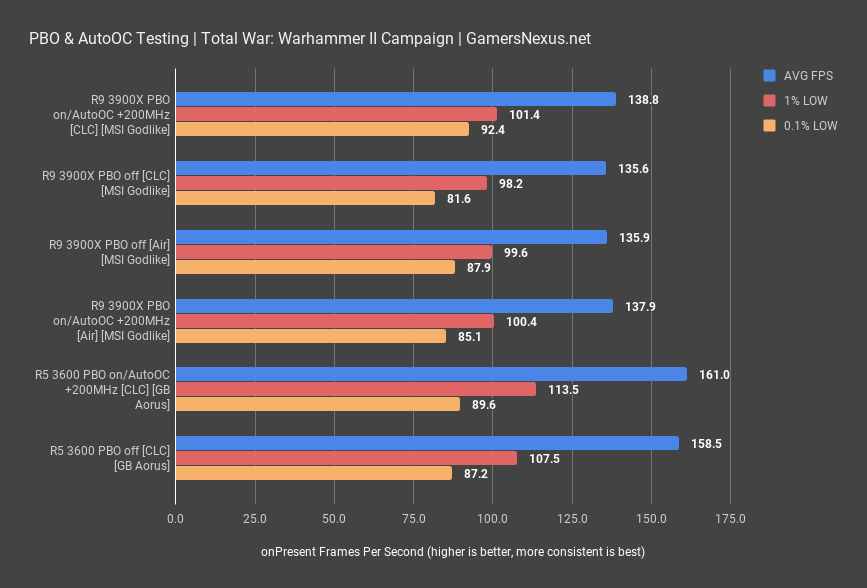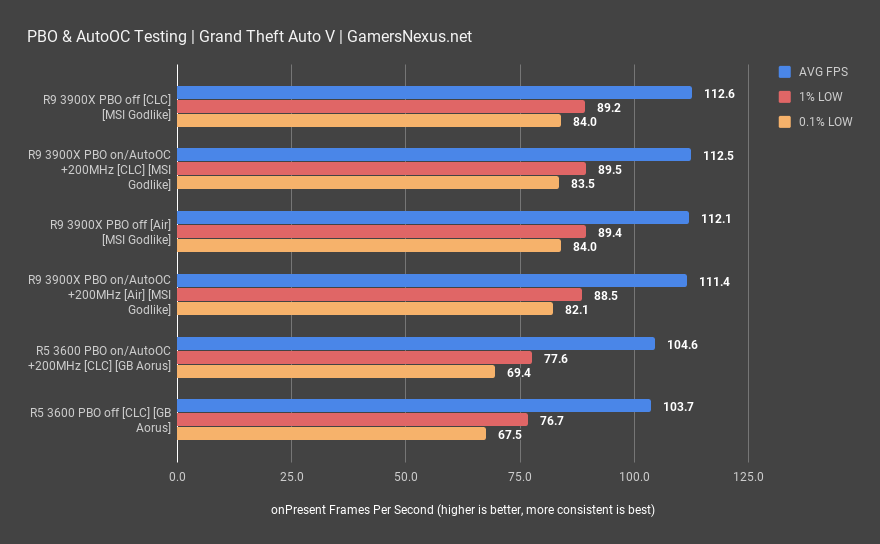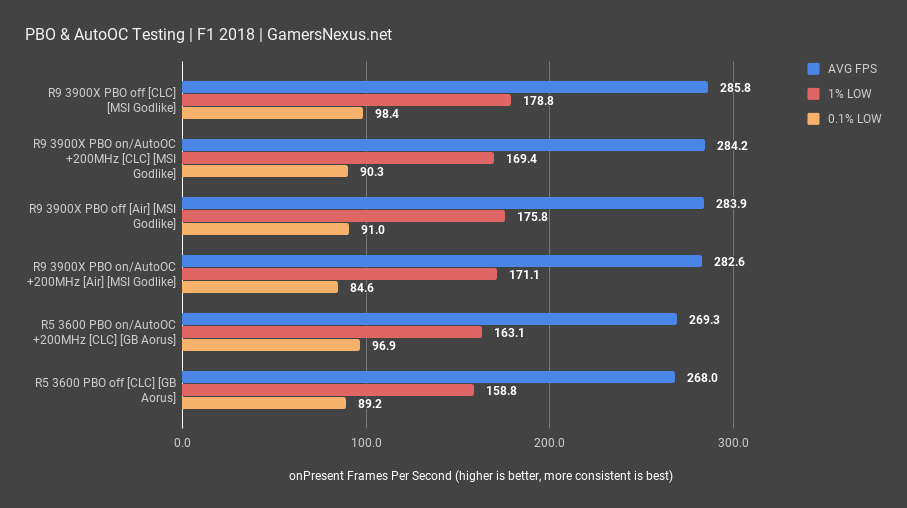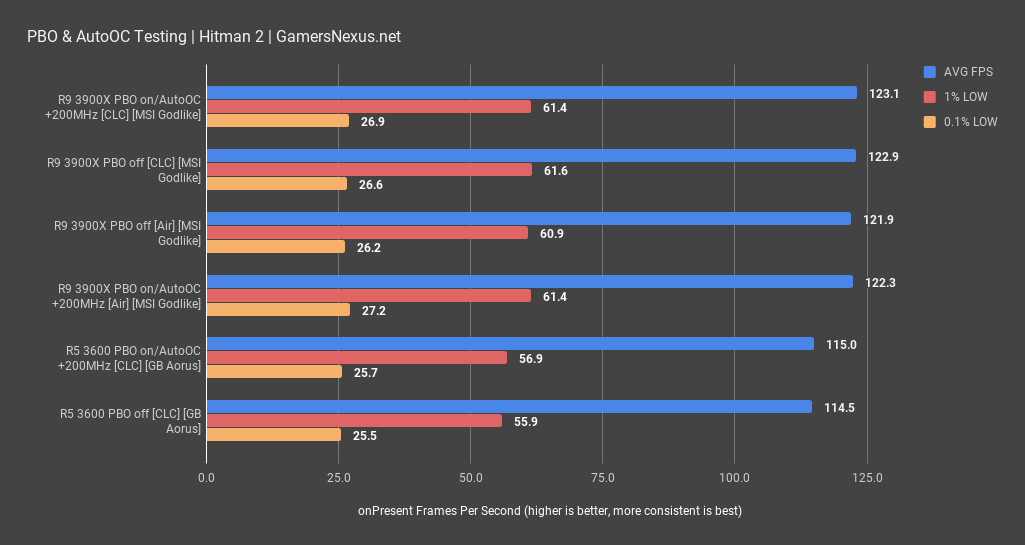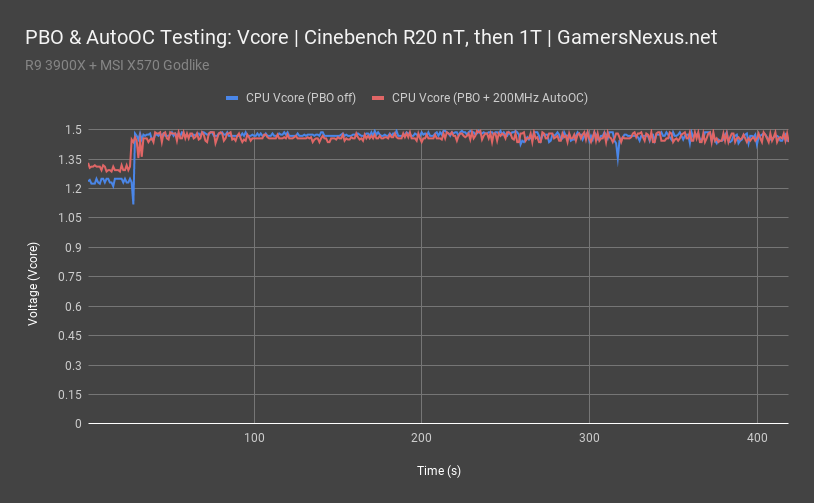Explaining AMD Ryzen Precision Boost Overdrive (PBO), AutoOC, & Benchmarks
Posted on
With the launch of the Ryzen 3000 series processors, we’ve noticed a distinct confusion among readers and viewers when it comes to the phrases “Precision Boost 2,” “XFR,” “Precision Boost Overdrive,” which is different from Precision Boost, and “AutoOC.” There is also a lot of confusion about what’s considered stock, what PBO even does or if it works at all, and how thermals impact frequency of Ryzen CPUs. Today, we’re demystifying these names and demonstrating the basic behaviors of each solution as tested on two motherboards.
Precision Boost Overdrive is a technology new to Ryzen desktop processors, having first been introduced in Threadripper chips; technically, Ryzen 3000 uses Precision Boost 2. PBO is explicitly different from Precision Boost and Precision Boost 2, which is where a lot of people get confused. “Precision Boost” is not an abbreviation for “Precision Boost Overdrive,” it’s actually a different thing: Precision Boost is like XFR, AMD’s Extended Frequency Range boosting table for boosting a limited number of cores when possible. XFR was introduced with the first Ryzen series CPUs. Precision Boost takes into account three numbers in deciding how many cores can boost and when, and those numbers are PPT, TDC, and EDC, as well as temperature and the chip’s max boost clock. Precision Boost is enabled on a stock CPU, Precision Boost Overdrive is not. What PBO does not ever do is boost the frequency beyond the advertised CPU clocks, which is a major point that people have confused. We’ll quote directly from AMD’s review documentation so that there is no room for confusion:
Package Power Tracking (“PPT”): The PPT threshold is the allowed socket power consumption permitted across the voltage rails supplying the socket. Applications with high thread counts, and/or “heavy” threads, can encounter PPT limits that can be alleviated with a raised PPT limit.
- Default for Socket AM4 is at least 142W on motherboards rated for 105W TDP processors.
- Default for Socket AM4 is at least 88W on motherboards rated for 65W TDP processors.
Thermal Design Current (“TDC”): The maximum current (amps) that can be delivered by a specific motherboard’s voltage regulator configuration in thermally-constrained scenarios.
- Default for socket AM4 is at least 95A on motherboards rated for 105W TDP processors.
- Default for socket AM4 is at least 60A on motherboards rated for 65W TDP processors.
Electrical Design Current (“EDC”): The maximum current (amps) that can be delivered by a specific motherboard’s voltage regulator configuration in a peak (“spike”) condition for a short period of time.
- Default for socket AM4 is 140A on motherboards rated for 105W TDP processors.
- Default for socket AM4 is 90A on motherboards rated for 65W TDP processors.
What is important to note is that PBO only affects these three power limits. The effect on CPU clock speed is indirect, and PBO will never boost the CPU past the advertised clocks. At best it will allow the CPU to maintain boost clocks longer and more often, and therefore PBO will have the strongest effect on scenarios where the CPU is already able to boost. Because one of the constraints is thermal, PBO will also have less effect on CPUs that are already well-cooled and not bumping up against that limit. Remember that in addition to these three power limits PB is constrained by temperature and max boost clocks, and these limits are not affected by PBO.
AMD has been extremely reluctant to commit to numbers for single core boost and all core boost, because Precision Boost uses an “opportunistic algorithm” to boost frequency until it hits one of those limits. AMD says the following of this: “At the limit, the processor will draw back on boost and dither the frequency until the situation changes. This dithering and analysis loop occurs every 1ms within the Infinity Fabric’s command and control faculties” and “the processor is designed to use thermal headroom to drive higher average frequencies, and thus more performance.”
The optimistic way to read this is that AMD is automatically pushing performance in a way that’s more sensitive and efficient than manual overclocking; the pessimistic way to read it is that it’s another variable out of control and an enormous pain for testing or comparative data, sort of like NVIDIA’s GPU Boost 4.0. We’re careful to use the same high-quality NZXT X62 liquid cooler on every CPU we test with the fans and pumps at max speed to avoid any throttling, eliminating the thermal variable, but if we weren’t or if a reviewer were less scrupulous, performance would be directly affected on Ryzen 3000 chips based on the cooler used. In the past, CPUs have been fairly forgiving, and as long as nothing hit TjMax, stock performance would be about the same. Our CPU review results are from an ideal scenario, showing the baseline maximum performance, and users who aren’t using a 280mm CLC on an open-air bench may not be able to match our performance. This further reinforces our opinion on picking a case with good thermals, by the way, so now’s a good time to start watching our case review backlog.
Precision Boost OVERDRIVE is what AMD is calling it when those three thresholds are bumped up. The default setting for PBO is “auto,” which the stock specification defines as disabled; further, AMD’s own review guide states to disable PBO for reviews, as the Overdrive portion is not spec. That’s what we did for our review, just like how we disable MCE for Intel. The default numbers can be pulled from the chip (overdrive disabled) or higher numbers can be pulled from the motherboard (overdrive enabled). Setting overdrive to “enabled,” setting overdrive to “advanced,” and specifying the motherboard as the source did the same thing on the two boards we tested for this content, but the two motherboards set different values. On the Gigabyte X570 Master with the 3900X, PBO limits were as follows: PPT 1200W, TDC 540A, and EDC 600A. On the MSI Godlike, the limits were: 1000W, 490A, and 630A. With PBO disabled the limits were PPT 142W, TDC 95A, and EDC 140A on both boards, which is correct AMD spec for 105W TDP processors. The limits adjusted downwards (to spec) when a 65W processor was installed with PBO still disabled. It sounds like motherboard manufacturers are free to set higher numbers based on what they expect their own boards and VRM to be capable of, although some of the motherboard makers we spoke to are under the impression that AMD provides these numbers, which is another issue entirely.
Also note that there are separate default PB limits for 105W and 65W TDP processors. When we installed a 3600 in our MSI Godlike, we got the 65W numbers; when we installed a 3900X, we got the 105W numbers. This means that the advantages PBO offers are subjective depending on the motherboard model, the processor model, the SPECIFIC processor, the cooling solution, the temperature of the room, and the alignment of the planets.
The 200MHz offset that’s mentioned in conjunction with PBO is called AutoOC. This is not technically part of PBO, despite being in the PBO menu in BIOS.
PBO sounds good. It is good. Allowing users to circumvent some of the touchy GPU-esque clock behaviors that are creeping into CPUs is great, especially for users who have the VRM and cooling solutions to handle speeds and voltages beyond AMD’s spec. On paper, it also sounds like a great way to get rid of the vastly diminishing returns from all-core overclocks over the past couple generations of AMD processors and give OCers access to a little performance.
AMD intends PBO and AutoOC to be used in conjunction with each other, with the AutoOC offset benefitting single-core boost and PBO benefitting multi-core loads that bump up against power limits. Here’s the thing: In our testing, none of this helps. At least not much, and certainly not for us. Just entering “200” does not mean it’ll always offset by 200MHz, it’ll just offset by any point within operating limits to a maximum of 200, similar to GPU clock offsets. We have a table from AMD that helps illustrate the intended use. AMD’s reviewer guide says that the offset only applies to the max boost clock, but a chart later on clarifies that this is the max boost clock for any number of cores. The Ryzen 9 3900X has a max listed boost clock of 4.6GHz. It may or may not ever hit this clock speed, depending on CPU and usage, and probably not on more than one core. With AutoOC, this theoretical limit is raised to 4.8GHz, but there’s still no guarantee the chip will ever hit that. From AMD: “this feature will not guarantee the higher boost clock on any number of cores. The frequency/cores/boost duration will still depend on the firmware-managed limits, even though those limits are higher than OEM when PBO has been enabled.” By this direction, enabling PBO and the offset make it more likely that the 3900X will maybe hit 4.8GHz on one core once in a while in Cinebench single-threaded benchmarks, and sometimes in extremely heavy all-core loads the CPU will run a little faster than it would with stock PPT/TDC/EDC limits, although the all-core load is barely affected by the 200MHz AutoOC offset in our testing (spoilers).
Once we had a handle on what PBO and AutoOC are supposed to do, we started testing. We began with an R5 3600 on the Gigabyte Aorus Master (used for our Ryzen 3000 reviews) and the MSI Godlike, reasoning that the most power-hungry sample chip we had with the lowest stock clocks would benefit the most from removing current limitations. This is the CPU that took more than 1.4V to complete our tests at 4.3GHz all-core when then 3900X could manage the same at 1.35V; it’s also the model of CPU that AMD showed gaining the most points in single-threaded performance with PBO+AutoOC. Note that we’re talking stock numbers with PBO as the A/B test, here, so all-core OCs are not part of this. MSI has another menu in addition to the generic AMD PBO submenu with some basic preset PBO profiles in it; we verified that all these profiles do is set PBO to advanced mode and max all the settings (except AutoOC, which again is technically a separate feature). Someone at MSI was paying attention to PBO enough to create these profiles, so we can assume that they’ve tailored the motherboard PPT/TDC/EDC limits to fit their board.
In the interest of not making this piece overly long, we’ll summarize the tests we ran and discuss all the results together. We tested the R5 3600 and the R9 3900X in the Gigabyte X570 Aorus Master and the MSI X570 Godlike motherboards, and we ran them with PBO disabled, PBO enabled (auto), and PBO maxed with a +200MHz AutoOC offset (includes maxing thermal throttle limit and PBO scalar menu options). We found that manually maxing the PBO variables and allowing the motherboard to set them accomplished functionally the same thing, so for “max” tests we used the motherboard values. We ran a mix of Cinebench R15, Cinebench R20, and 1080p game tests. We didn’t run all tests on all configurations because it would have been a waste of time; the tests in the charts are the tests we ran. We also ran two further passes with the 3900X in the Godlike board with the CLC fan and pump speed slowed, PBO on and off, to see whether Overdrive is more helpful when the CPU is warmer.
On the X570 Master with the R5 3600 and PBO disabled, Cinebench R20 scored 3759 multithreaded/484 single threaded. Simply setting PBO to “enabled” scored 3748/485, and setting PBO to motherboard limits (functionally the same as max), maxing throttle temp and PBO scalar, and applying the AutoOC 200MHz offset scored 3765/496. That’s a 0.2% improvement over stock for the multithreaded score, absolutely within range of variance, and a 2.5% improvement in single core performance. AMD showed a 21 point increase for 1t performance in this test, we showed a 12 point increase; we can’t tell you a percent difference for AMD’s numbers because they omitted a vertical axis on their marketing charts, attempting to render them as useless as possible. Cinebench R20 single-threaded on the R5 3600 is AMD’s absolute best-case scenario for PBO+AutoOC, and it barely does anything in their own testing: if their stock single-core score somehow exactly matched ours, and it should be close, AMD’s 21 points would be 4.3% increase. On the Godlike board we saw a 3.5% increase from PBO disabled to PBO maxed with AutoOC.
We also ran Cinebench R15, so let’s take a look at the R9 3900X for that benchmark. The lowest single-threaded score we saw was with PBO and AutoOC on the Aorus board--and this is where our next big hurdle started to become visible. Precision boost is so reactive that the variance between test results from one day to the next can be larger than the difference between OC and stock, or stock and PBO. For a more logical comparison, the Godlike improved 2.5% moving from PBO off to PBO maxed with 200MHz AutoOC, but then zero single-threaded improvement. We didn’t bother running more synthetics than Cinebench for this content piece because PBO is supposed to be primarily beneficial to gaming and because the run-to-run variance with Precision Boost was starting to drive us insane; we demonstrated why in our livestream, but will work on another content piece separately to drive it home. Basically, every couple of degrees change in CPU temperature will affect frequency in a measurable way for results, and so the order of tests completed will impact results, the pause between tests, the room temperature, and more. We control all of these things as best we can, especially room temperature, but it’s still tough to fight. This is partly a good thing from the standpoint of improving the CPU’s performance, but difficult for testing tiny differences. AMD doesn’t guarantee AutoOC will actually increase clocks and PBO’s effect is inconsistent at best. Stick around for the end of this piece where we dig into Precision Boost’s behavior at sub-zero temperatures for some explanation.
For game testing, we felt things out first by testing with Civilization VI, a consistent benchmark that should benefit from frequency increases across a limited number of threads. On the 3900X, turn time completions were almost exactly the same regardless of the cooler or if PBO or AutoOC was enabled. All of the 3900X results were gathered on the Gigabyte board. The test with the CLC and PBO disabled may have been marginally better than with the air cooler, but a 1.2% reduction in turn time isn’t concrete. Results for the 3600 on the MSI board with PBO/AutoOC on and off were identical, and the results on the Gigabyte board were so close to each other that they may as well have been.
We have a more limited set of results for the Total War: Warhammer 2 Battle benchmark, just the 3900X on the MSI board with an air cooler and a liquid cooler. For once the results somehow lined-up in a sane and reasonable fashion, with the two PBO/AutoOC enabled tests at the top and the two stock tests at the bottom, with the best result from a CLC and the worst result from an air cooler. There’s a 2.6% improvement between the worst result and the best result. Patrick, who wrote most of this script, noted that he hopes everyone can appreciate the amount of time and effort we’ve put into testing a feature that nobody understands and that barely does anything.
The Campaign benchmark also showed some scaling on each of the board and cooler combinations. The improvement from PBO off to PBO/AutoOC on with the 3900X and a CLC on the MSI board was a whopping 2.4%, and 1.5% on air. Despite being a lightly threaded workload, it doesn’t seem that Total War benefits hugely from the 200MHz offset, but then again nothing else has either. The 3600 scaled 1.6% with PBO and AutoOC enabled on the Gigabyte board. We would normally avoid such a patchy mix of hardware and tests, but we’ve been trying to cast as wide a net as possible to find any situation in which PBO and AutoOC provides a genuine advantage.
Shadow of the Tomb Raider showed no significant change based on PBO or AutoOC on the MSI board with a 3900X air cooler, air cooler or not, or on the Gigabyte board with a 3600. It’s hard to get results this unchanging when we actually want them.
Again, the GTA results for the 3900X were almost all the same regardless of context. The result with an air cooler and PBO and AutoOC enabled was very slightly worse than the other three, presumably because of minor temperature fluctuations from repeated loads in rapid succession, or from a reasonable +/-1C change in room temperature as AC fluctuated, but it’s still a difference of barely more than 1FPS from the top result (which was achieved with PBO and AutoOC disabled). The R5 3600 on the Gigabyte board also scored two results within margin of error.
The worst result for the 3900X in F1 2018 was with the air cooler and PBO/AutoOC enabled; the best result was with a CLC and PBO turned off. Our initial theory that PBO would help get around thermal constraints hasn’t panned out, illustrated here. The difference is still a miniscule 1.1% gain between the worst and best results, however. With the 3600 on the GB board, there’s also less than a 1% increase between the two scores.
Our final gaming benchmark was Hitman 2 (DX12). The best result achieved for the 3900X was with PBO and AutoOC under a CLC, and the worst was with an air cooler and PBO disabled, but the gap is still so incredibly small. It’s even smaller with the 3600 on the Gigabyte board.
We failed to find a single game where enabling PBO and AutoOC made a significant difference, and PBO + AutoOC is intended to improve gaming performance. “More clock speed, for longer, means more performance. Especially in games. They just love extra clock speed.” We could test more combinations of boards and chips, but it just isn’t happening without completely changing the definition of PBO. The power delivery capabilities of the boards we tested is high, and Ryzen Master reports that the 3900X and the 3600 both fall well below the motherboard-defined PBO limits. Motherboard manufacturers could triple PBO limits tomorrow (if they’re even the ones that control those numbers) and it wouldn’t make a difference based on what we’ve seen.
For our final charts, we’d like to show some of the difference in power and frequency behavior with PBO on and off. We did a lot of logging, but we’ve picked two runs as representative from the R9 3900X on the MSI Godlike board, one with PBO disabled completely and one with PBO enabled and set to motherboard limits with a 200MHz AutoOC. We started HWiNFO64 logging, put a current clamp around the CPU 8-pin power connectors, and ran Cinebench R20, first multithreaded and then single threaded (in the same log file). For these runs, we scored 514/7078 1t/nt with PBO off and 520/7235 with PBO and AutoOC on. We’ve scored better with this chip and board with PBO disabled, and still there’s only a 1.2% improvement 1t and a 2.2% improvement nt, but if any pass of any test is going to show a difference in frequency, this is it.
We’re showing the peak core clock here because that’s the boost clock, which PBO/AutoOC is supposed to benefit, and because the average core clocks are even closer to identical. During the multithreaded load at the beginning PBO and AutoOC maintains a 50MHz advantage, but during the single threaded test any difference is imperceptible, although the higher result with PBO and AutoOC on indicates there must be some delta. Averaging the peak frequencies during the single threaded runs comes out to roughly 4514.4MHz with PBO off and 4519.5MHz with PBO and AutoOC on.
Vcore as reported by HWiNFO had a more obvious delta during the multithreaded test, holding to 1.24V average with PBO off and 1.3V average with PBO and AutoOC. The single threaded test again shows barely any difference, and in fact taking an average has PBO disabled ahead of the other result at 1.47V versus 1.46V, but that difference is negligible.
Our preferred method for logging power is with a current clamp. With PBO disabled we logged 11.6A multithreaded and 3.3A single threaded (139.2W/39.6W), and with PBO and AutoOC maxed we logged 14.2A multithreaded and 3.4A single threaded (170.4W/40.8W). The multithreaded amperage actually spiked to 14.8A at the beginning and dropped as low as 13.9A during the (fairly brief) run, which was corroborated by HWiNFO’s power numbers.
By this point in testing we had seen so much variance in clocks and scores that we knew Precision Boost was affecting our results. We have liquid nitrogen on hand, so it was easy for us to just dump some of it onto a 3900X and see what it would do under absolutely ideal conditions, stock or with PBO. We’ll expand on this more in a future piece, but for now we can say that running Cinebench R15 with tdie at about 62 degrees Celsius scored 3163 points, and that score scaled all the way up to 3427 followed by a bluescreen at -56C LN2 pot temperature (similar and more stable scores were achieved at -30C). These were just some rough tests to see if PB would continue scaling clocks with temperature down to sub-zero, and it did. Nothing else was changed, no overclocking was done, we just made it colder. We were maintaining up to nearly 4.4GHz all-core in Cinebench completely stock, PBO disabled, higher than the highest all-core overclock we could achieve with a 280mm CLC and all without voiding the warranty (PBO voids your CPU warranty, but dumping LN2 onto it and leaving it stock technically does not void the warranty, stupidly). In fact, enabling PBO and 200MHz AutoOC locked us to a maximum 4.2GHz all-core, and 4.25 with AutoOC disabled. This could be down to Gigabyte and we still need to replicate the behavior on other boards, but it’s bizarre either way. We’re never seeing the 200MHz boost from AutoOC.
Especially in light of the LN2 results we’ve gathered so far, it seems like PBO is pointless. The limits that it’s raising aren’t limits that are restricting performance. What matters far, far more is temperature, and even at liquid nitrogen temperatures the CPU increases its clocks just fine without any changes to PBO, and in fact PBO worsened performance due to a bug either on Gigabyte’s board or all X570 boards. Even at Wraith-Spire-that-isn’t-rated-for-the-3900X temperatures, PBO didn’t make a significant difference. We’ll work on nailing down which setting is restricting the clocks to 4.2GHz with PBO enabled under LN2 and whether it occurs on other boards, but regardless of the verdict, we still haven’t discovered a single scenario in which PBO makes a meaningful difference in performance.
We also have to include a caveat that we don’t think Ryzen 3000 processors are bad, and you can check our reviews for opinions on each SKU. Precision Boost is a finicky pain from a reviewer standpoint and a smart way to squeeze performance from an AMD (and maybe consumer) standpoint. Precision Boost OVERDRIVE and AutoOC are poorly named and poorly explained features that barely do anything and just serve to confuse the discussion.
Editorial, Testing: Patrick Lathan
Host, Test Lead: Steve Burke
Video: Andrew Coleman, Keegan Gallick

